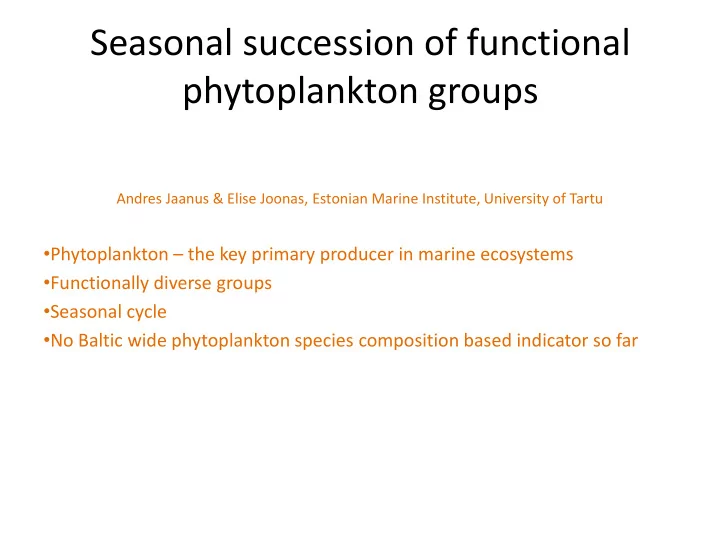

Seasonal succession of functional phytoplankton groups Andres Jaanus & Elise Joonas, Estonian Marine Institute, University of Tartu • Phytoplankton – the key primary producer in marine ecosystems • Functionally diverse groups • Seasonal cycle • No Baltic wide phytoplankton species composition based indicator so far
Seasonal succession of functional phytoplankton groups • HELCOM Assessment Unit Level: 3, 4 • The indicator is applicable in: all coastal areas around the Baltic Sea / open sea • Test areas: Southern Gulf of Finland, coastal Gulf of Gdansk • Data provided: northern Gulf of Finland, Gulf of Riga, (Curonian Lagoon)
Seasonal succession of functional phytoplankton groups Analysis description 1) Wet weight biomasses of four major functional groups, including cyanobacteria, dinoflagellates, diatoms and the autotrophic ciliate Mesodinium rubrum are averaged for each month over a sampling year. 2) Skewed data is accounted for by the transformation of phytoplankton biomass on a natural log scale (ln bm). 3) Monthly mean and standard deviations are calculated for each functional group 4) Monthly Z scores are calculated by subtracting the overall mean from the overall monthly mean of the reference period and dividing with overall stdev. 5) Acceptable deviations for monthly values are calculated (Z-scores ±1/2 stdev) A positive Z score indicates that the observation is greater than the mean and a negative score indicates that the observation is less than the mean. 6) Type-specific reference curves are established (mean and ±acceptable deviations)
Seasonal succession of functional phytoplankton groups Assessment procedure 1) Data points are calculated as in 4 of analysis description, the overall monthly means are replaced with the monthly means of the reference period. 2) The score is based on the number of data points from the test area which fall within the acceptable deviation range set for each monthly point of the reference growth curve 3) Percentage based thresholds are established for each functional group to determine GES boundary (EQR values) for the assessment of the ecological status The GES boundary in the southern Gulf of Finland has preliminarily set at EQR value 0.67
Seasonal succession of functional phytoplankton groups Reference envelope (mean ± 0.5 SD ) , diatoms, Tallinn Bay • Tested in the Gulf of 3 Finland, Gulf of Gdansk zmonth • GES is determined by the ln biomass, µg l -1 Zmonth+0.5 SD 1 Zmonth-0.5 SD no. of observations falling 2009 inside the reference 2010 -1 envelope (EQR) 2011 2012 • EQR GES/sub-GES =0.67 (may 2013 -3 be different in different 4 5 6 7 8 9 10 sub-basins) mean SD year 2.83 3.02 Z month +0. Z month -0.5 month mean SD n SE zmonth 5 SD SD 2009 2010 2011 2012 2013 4 6.91 1.38 38 0.22 1.35 1.85 0.85 1.39 1.52 1.80 1.85 1.53 5 5.17 2.44 71 0.29 0.78 1.28 0.28 0.51 0.50 1.03 1.46 0.05 6 2.10 2.34 69 0.28 -0.24 0.26 -0.74 0.14 -0.33 -1.38 -0.04 0.31 7 0.88 2.77 74 0.32 -0.65 -0.15 -1.15 -1.84 -0.17 -0.44 -0.31 -0.47 8 1.36 2.75 73 0.32 -0.49 0.01 -0.99 -0.21 -0.14 -0.12 0.02 0.24 9 2.91 1.92 40 0.30 0.03 0.53 -0.47 -0.04 -0.14 -0.48 1.02 0.15 10 3.39 1.97 41 0.31 0.19 0.69 -0.31 -0.06 0.60 -0.15 0.32 0.80
Seasonal succession of functional phytoplankton groups • Concept and analysis design in place • Technical guidelines in place • Assessment method available and described • Definition of reference conditions based on expert judgment • GES proposed, but needs more supporting data and discussion • Requirements for datasets: – at least monthly sampling to design reference growth curves (time-series of at least 10 years needed) – Should be focused on areas/sites with historical datasets – Data submission arrangements to be incorporated into the indicator should be discussed, preliminary strategy and schedule agreed among experts - TM, HELCOM
Seasonal succession of functional phytoplankton groups List of issues that still need Describe what is hindering solving the issue to be solved for the indicator Low confidence in the result Funding for data collection and analysis is still unsecure and the amount of data needed for the analysis has not yet been met. Low number of sites/basins meeting Insufficient monitoring frequency, too short time-series the criteria Weak coordination of monitoring activities in the open sea areas
Recommend
More recommend